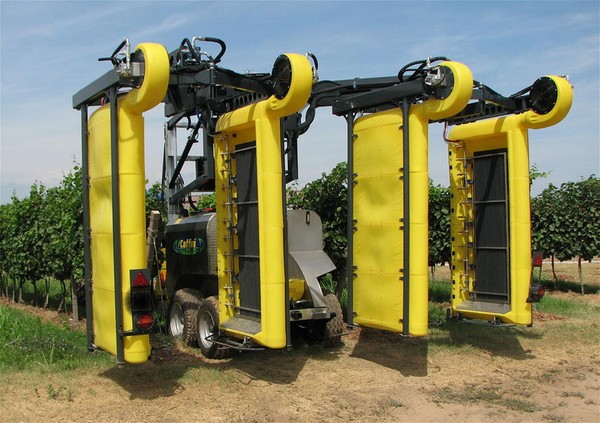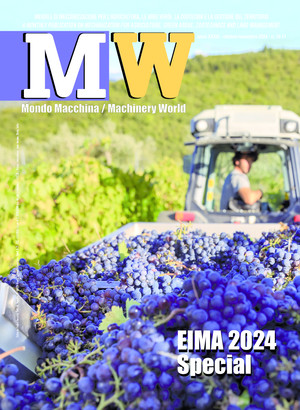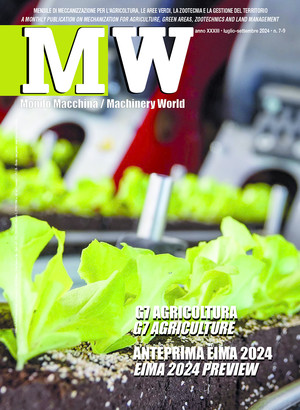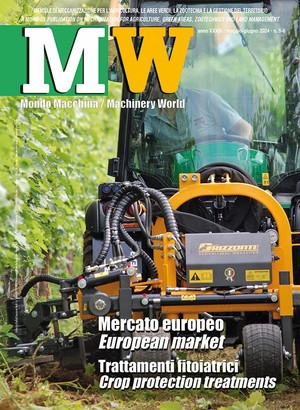
Agricultural machinery, not everything is steel
Stainless steel, ceramic, tungsten carbide, fiberglass, plastics and even concrete. These are just some of the alternative materials to steel now commonly adopted for the manufacture of parts, equipment, elements, components and accessories of agricultural machinery
Megghiu cunzumassi che arrugginissi”, goes an old Sicilian saying. That is: “better to wear out than to rust out.” Applied to the world of agricultural machinery, it recalls the hard work of the agricultural soil, which, due to friction, progressively consumes tools subject to wear. The meaning is clear: a worn tool did a lot of work, and therefore it was useful and profitable, as opposed to a rusty one, which was inoperative, and therefore useless.
In any case, reference is made to an incontrovertible reality, namely that almost all agricultural machinery is built with metals obtained from iron ore, in its various versions: cast iron, soft iron, ferrite, common steel, special steels, etc. This is absolutely logical and normal, considering that this raw material is very common on our planet, and its derivatives show a set of characteristics that in most cases are well suited to the needs of mechanised agricultural work. When, for example, only weight is needed, cast iron is well suited, since the volumetric mass of this derivative (as well as steel) is almost 8 times higher than that of water, which is the reference; if vice versa elasticity is needed, steel, a decidedly more refined derivative, is well suited. Moreover, steel can still be combined into numerous alloys (with Molybdenum, Chromium, Nickel, Vanadium, Boron, Tungsten, etc.) and further subjected to a series of treatments, essentially of a thermal type, which can modify its qualities in terms of strength, hardness, ductility, toughness and resilience. However, even in agricultural machinery, not everything is simple “iron”... There are countless parts, equipment, elements, components and accessories that are usually produced with variants and derivatives of the iron material, and especially with different materials, both metallic and not. The following is a very brief (and largely incomplete...) overview on the subject.
Stainless steel. Probably the most frequent evolution of common carbon steel is the stainless steel version, i.e. its combination with chrome (generally 12-18%, possibly also integrated with nickel or molybdenum), which, when oxidised, deposits into a very dense and very thin outer layer (3-5 x 10 -7 mm thick), however sufficient to effectively avoid corrosion. Not only that, but stainless steel is also characterised by a remarkable surface hardness, which is well suited to those applications that require it. Obviously, this also has some disadvantages, mainly due to the higher cost and the greater difficulty of processing normal carbon steels.
However, there are many uses of stainless steel in agricultural machinery: for example, a relatively recent one is the manufacture of vertical augers for mixing wagons. Kuhn has recently adopted “K-Nox” technology for the augers of its models, thanks to which the magnitude of both chemical and mechanical wear is considerably reduced, despite the significant corrosive potential caused by the acidity, even significant, of the most common livestock feed products (pH of corn silage 3.9; grass 5.8; soybean meal 6.7) and silica, a notoriously abrasive component on metal parts. In more detail, the name K-Nox refers to an alloy composed of chromium and ferrite, where the former guarantees resistance to chemical wear, while ferrite provides the mixing auger with the necessary mechanical strength.
The manufacturer declares that K-Nox vertical augers have a significantly longer lifespan than usual, to avoid a potential risk of breakage even after several thousand hours of work.
Tungsten carbide. Still on the subject of tillage, to effectively deal with the problem of wear of the working parts, materials are used that are much stronger than steel, such as tungsten carbide, by replacing the most stressed parts, or more frequently with the application of specific inserts. Their creation requires a very precise control of each phase of production. After sintering, i.e. the transformation by heating of a material from a powdery form to a solid one, several compression molding steps are performed, to obtain the inserts that will be placed, often by brazing, in their final position, sometimes with a heat treatment of the entire component at 800°C for better structural homogeneity of the piece.
Plastic and fiberglass material. In certain cases, plastic materials can constitute a valid alternative to the use of steel, such as for example for the construction of plough furrows and mouldboards, where technological development has concerned the reduction of friction between the tool and the ground, to reduce the traction force required to till the soil. Among the various solutions, those that have been somewhat successful concern the coating of the sliding surface of the mouldboard with polyethylene or Teflon, or, alternatively, the manufacture of the entire mouldboard, always in polyethylene, often supported by a steel reinforcement skeleton.
In more detail, the Robalon developed fifty years ago by the Austrian Röchling Leripa Papertech is very high molecular density polyethylene (UHMW-PE), combined with molybdenum disulfide, binders and UV stabilisers. Compared to traditional metal constructions, this plastic material has reduced friction and therefore less wear, low adhesion on the surface in contact with the ground and, of course, a lower weight (up to 60% less), with the same dynamic resistance. This therefore makes it particularly suitable for working in sticky soils, where the soil tends to adhere to the mouldboard. It is therefore not surprising that many manufacturers have models in their catalogue with mouldboards built (or covered) with plastic material, achieving some fuel savings during processing and being able to maintain slightly higher working speeds than equivalent traditional ploughs.
The guards of almost all cardan shafts are also made of polyethylene, which in this case is well suited for its elasticity and is also very economical. However, in relation to this specific application, it is a material that does not have optimal characteristics in relation to various attacks, both mechanical and chemical shocks, but also in relation to UV aging, which over time cause cuts, fissures, deformations, browning, cracks and crumbling of different parts of the protection, compromising the effectiveness of segregating the serious danger posed by the rotating cardan shaft. Polypropylene or polyurethane can improve the situation, but there is no doubt that a steel sheet protection, although more expensive and less flexible, would guarantee a much longer lifespan.
Polyethylene (PE), but also fiberglass (GRP, Glass-Reinforced Polyester) are the most common materials used for the construction of mixture tanks on sprayers. Both involve numerous positive qualities and obviously some critical issues, such as to make it possible to opt for one or the other solution depending on the needs. Polyethylene has several advantages: good resistance to shocks, chemical corrosion (due to contact with acids, alkalis, alcohol, gasoline, salt solutions, etc.), high temperatures (up to
130 °C for high-density PE), good light weight (0.9-0.95 kg/m³). Another very favourable aspect of polyethylene in the construction of tanks lies in the possibility of obtaining models with even very elaborate shapes through rotational moulding, with which robust, seamless, lightweight, monolithic containers without internal tensions are obtained.
Basically, in a mould made of shaped and welded steel sheet, or in cast aluminium, polymer powder is loaded, which is heated and rotated along one or more axes, so that it can liquefy and adhere to the walls of the mould homogeneously, taking its shape.
Fiberglass shows high resistance to compression, thanks to plastic resins, but also to traction, due to the presence of glass fibers. In addition, it has a limited volume mass, a valid inertia to the aggression of most chemical substances and to corrosion (even of the electrolytic type), it is stable to UV radiation and temperature changes. Finally, it has a pretty long lifespan. If damaged, it can be easily repaired, but with the same capacity, the cost of the fiberglass tank is higher than the polyethylene equivalent.
Ceramics. From a chemical-physical point of view, the main advantage of ceramic is its high resistance to wear (both due to chemical corrosion and friction), conferred by its typical hardness. However, it is necessary to consider its notable fragility, which is ill-suited to uses involving mechanical shocks. In general, these are favourable conditions for its successful adoption in the construction, for example, of the nozzles of sprayers, in particular the spray tips. In this case, for the production of drops of a constant diameter over time, it is important that the diameter of the hole does not undergo undesirable increases, due precisely to wear.
Moreover, other materials are commonly used for the manufacture of nozzles: brass, for slit and mirror spray tips, and some plastic materials (such as polyvinyl chloride or polypropylene) especially for slit nozzles, which are cheaper, but with limited resistance to wear; stainless steel is in an intermediate condition.
Concrete. It may seem rather strange, but one of the most common materials suitable for building constructions has been used for some time now also for the manufacture of tractor ballasts which, as is known, have the dual purpose of increasing the shooting capacity of the machine, through an appropriate increase in its adherent weight and, if placed at strategic points in the vehicle, to rebalance the distribution of the masses of the tractor-operator complex. In this case, as an alternative to classic cast iron or magnetite, monolithic ballasts are used in vibrated concrete (or even fibre cement) of various shapes, placed cantilevered in front of the front axle of the tractor and almost always of significant mass (even over 3,000 kg), such as to be necessarily managed with the aid of the front lift. Concrete is a much less expensive material than cast iron; its relative fragility is overcome with an internal framework made of steel profiles, which also serves as a coupling structure for the 3-point attachment. Despite having a volume mass 3 times lower than that of cast iron (2,400-2,600 against about 6,800-7,800 kg/m³), concrete is therefore a valid alternative for improving the traction performance of agricultural tractors.








